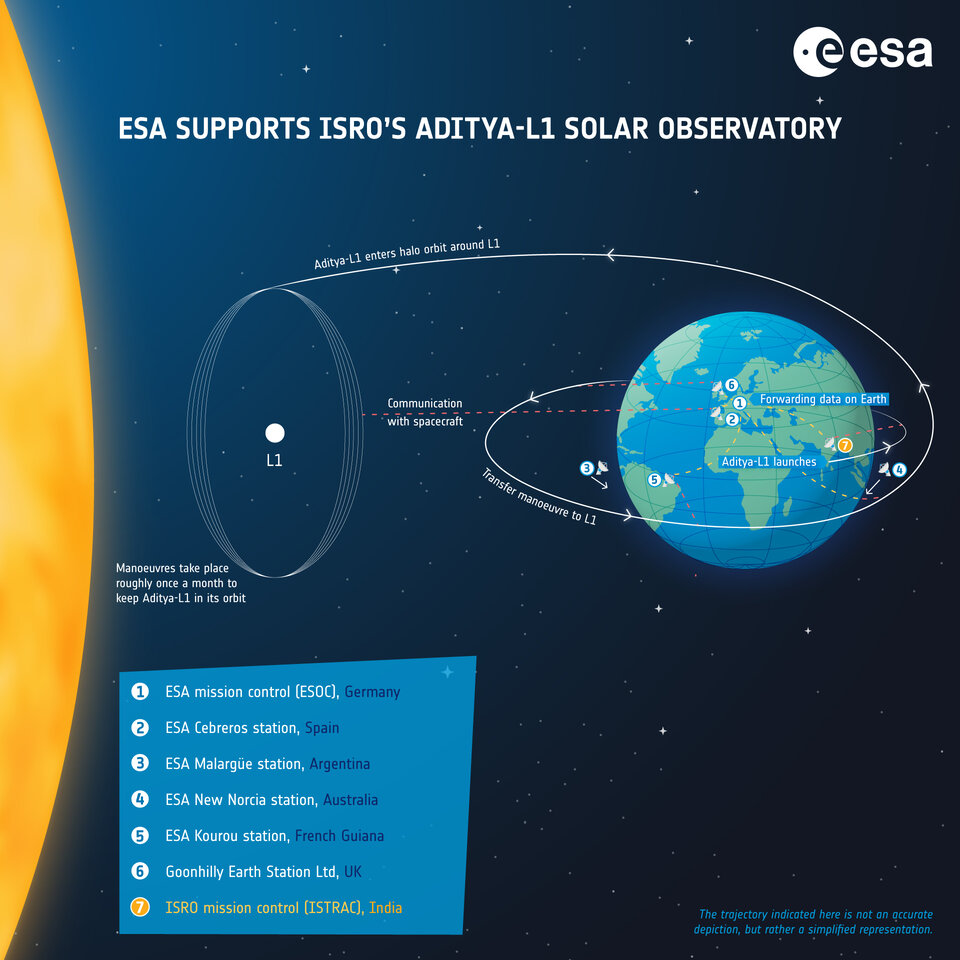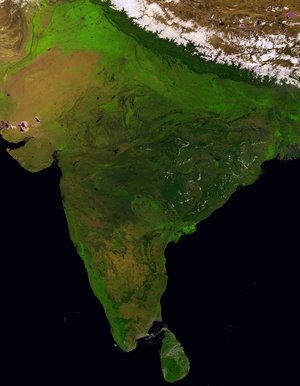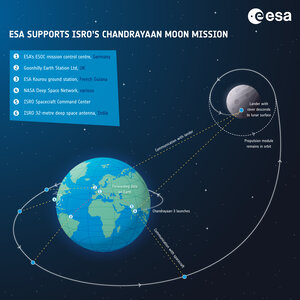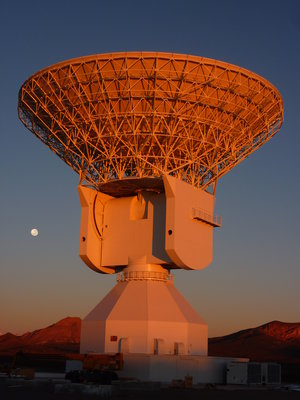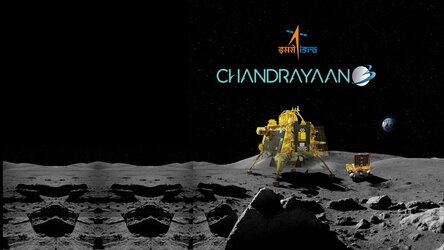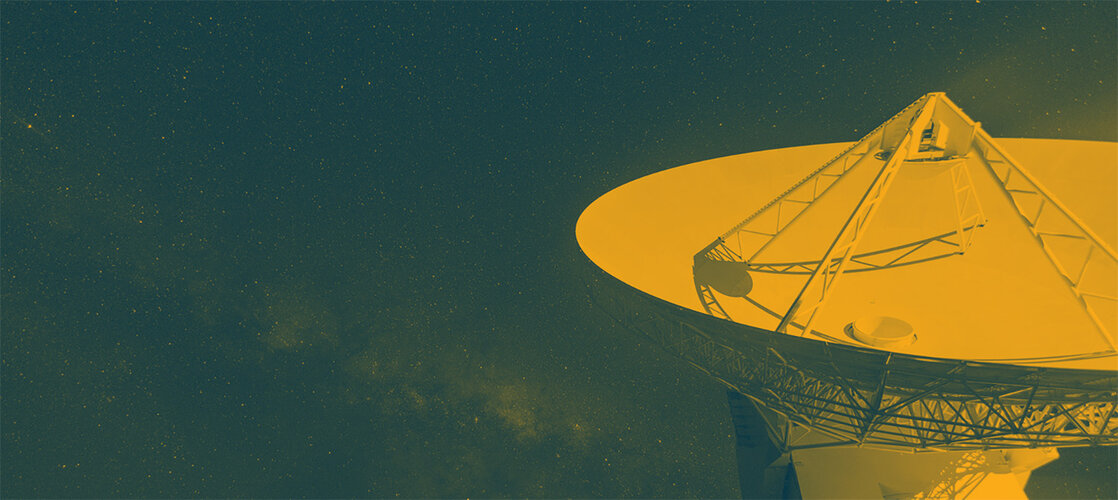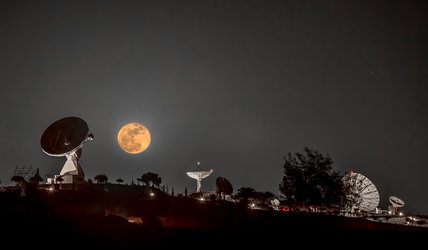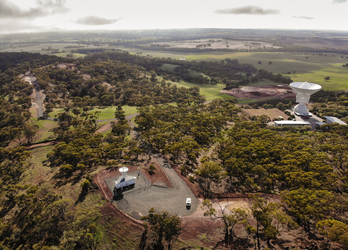How is ESA supporting ISRO’s Aditya-L1 solar mission?
UPDATE: Aditya-L1 was successfully launched from the Satish Dhawan Space Centre in Sriharikota Range (SDSC SHAR), India, on 2 September at 11:50 IST (08:20 CEST).
The Indian Space Research Organisation (ISRO) plans to launch its Aditya-L1 solar observatory from Satish Dhawan Space Centre in Sriharikota Range (SDSC SHAR), India, at 11:50 IST (08:20 CEST) on 2 September 2023.
It’s an ambitious mission that will generate vast quantities of science data as the spacecraft balances in an unstable orbit. With its global network of deep space ground stations and experience flying similar missions, ESA has just the right infrastructure and expertise to provide support.
Aditya-L1
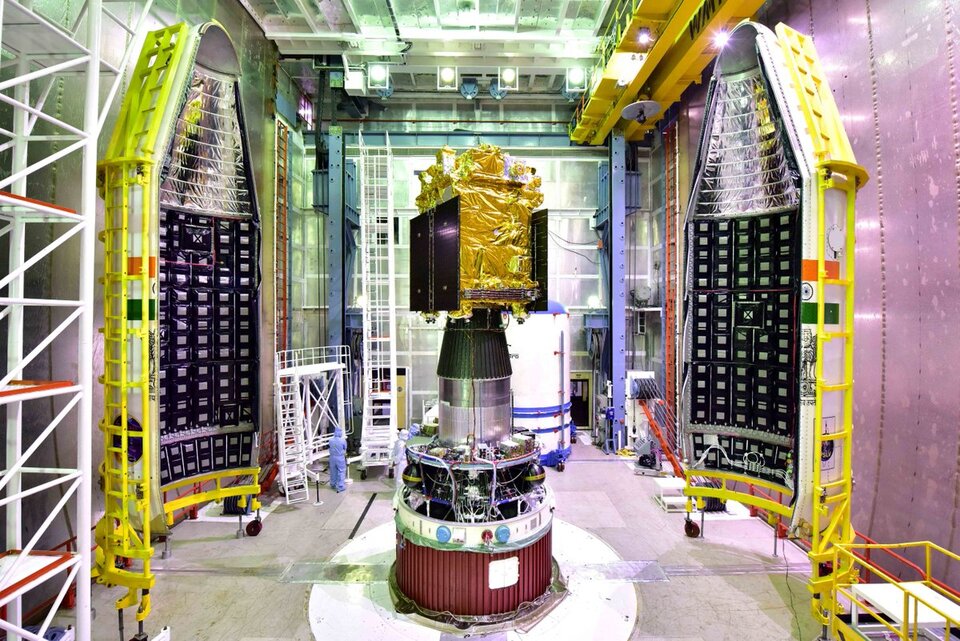
Aditya-L1 will be the first Indian satellite mission to study the Sun. After launch, the spacecraft will travel to its new home – the first Lagrange point (L1) of the Sun-Earth system.
From there, its seven instruments will be used to investigate open questions about our dynamic and turbulent star. Four of them will view the Sun directly, while the other three will carry out in-situ measurements to explore the nature of the space weather that the Sun generates in interplanetary space.
ESA support to Aditya-L1
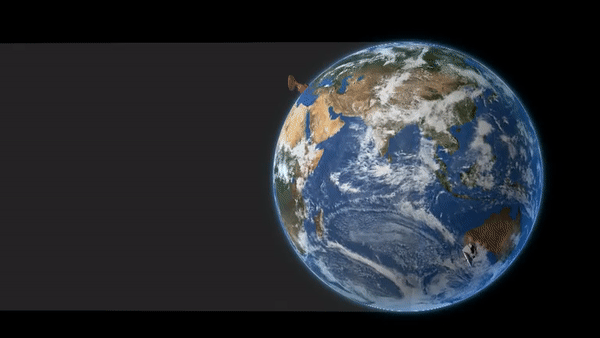
ESA is supporting Aditya-L1 in two ways: the Agency is providing deep space communication services to the mission, and, last year, ESA assisted ISRO with the validation of important new flight dynamics software.
Communication is an essential part of every space mission. Without ground station support, it’s impossible to get any science data from a spacecraft, to know how it’s doing, to know if it is safe or even to know where it is.
“ESA’s global network of deep space tracking stations and use of internationally recognised technical standards allows us to help our partners track, command and receive data from their spacecraft almost anywhere in the Solar System,” says Ramesh Chellathurai, ESA Service Manager and ESA Cross-Support Liaison Officer for ISRO.
“For the Aditya-L1 mission, we are providing support from all three of our 35-metre deep space antennas in Australia, Spain and Argentina, as well as support from our Kourou station in French Guiana and coordinated support from Goonhilly Earth Station in the UK.”
ESA is the main provider of ground station services for Aditya-L1. ESA stations will support the mission from beginning to end: from the critical ‘Launch and Early Orbit Phase’, throughout the journey to L1, and to send commands to and receive science data from Aditya-L1 for multiple hours per day over the next two years of routine operations.
Lagrange point 1 – a perfect home for solar explorers
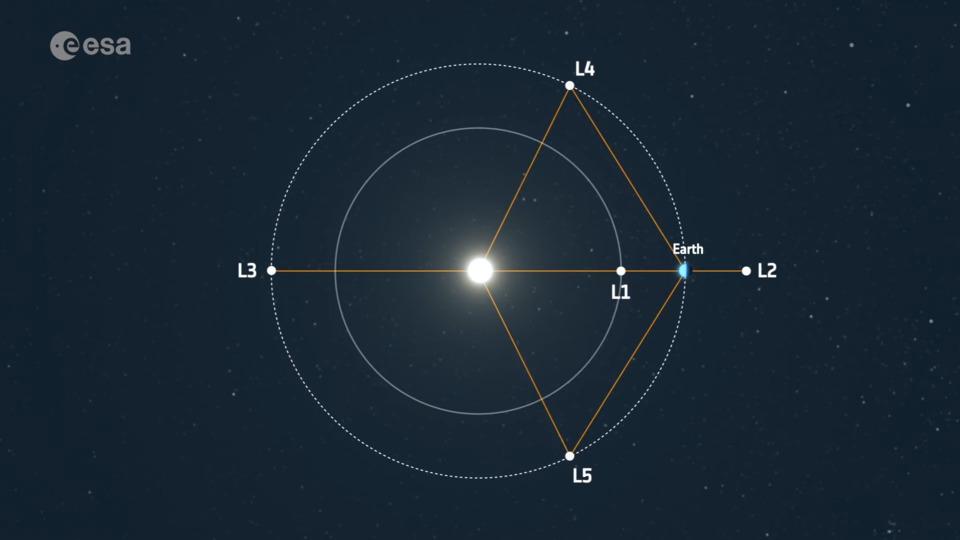
When one large mass orbits another, their gravitational forces and orbital motion interact to create five equilibrium points where a spacecraft can operate for a prolonged period of time without having to use a lot of fuel. These locations are known as Lagrange points.
The first Lagrange point, L1, is located between Earth and the Sun, roughly one percent of the distance to the Sun. It’s a great location for solar explorers such as Aditya-L1, as it allows for an unobstructed view of the Sun that is never eclipsed by Earth. At L1, Aditya-L1 will join spacecraft such as the ESA/NASA Solar Heliospheric Observatory (SOHO), which has been at L1 since 1996.
Spacecraft that are designed to look outwards at the outer Solar System and far beyond, such as the NASA/ESA/CSA James Webb Space Telescope or ESA’s Euclid and Gaia telescopes, instead travel to L2. L2 is an opposite to L1, located the same distance from Earth but on the other side of the planet, as seen from the Sun. At L2, these spacecraft always have the brightness of the Sun and Earth behind them as they gaze outwards at faint objects hiding in the darkness of the Universe.
Getting there

Aditya-L1 will not travel to L1 directly from launch. Instead, ISRO operators will need to perform a ‘transfer manoeuvre’ similar to the one that ESA performed recently to take its Euclid telescope to L2.
This manoeuvre will be performed soon after launch, as the amount of fuel required to achieve the necessary trajectory grows quickly with time. Aditya-L1 will first perform manoeuvres to adjust its orbit around Earth after launch, before performing a transfer manoeuvre to L1. The spacecraft will reach L1 approximately 100 days after launch.
Staying there
L1 is one of the ‘unstable’ Lagrange equilibrium points. Keeping a spacecraft exactly at the L1 point is practically impossible.
Instead, spacecraft enter orbit around L1 as if the Lagrange point were an ‘invisible planet’. Even so, due to the instability of this orbit, small trajectory errors will grow quickly. As a result, spacecraft must perform ‘station keeping’ manoeuvres roughly once a month to keep them in the correct orbit.
An inability to perform these monthly manoeuvres can be a big problem. In June 1998, the SOHO mission experienced an issue and failed to carry out its station keeping. The error in its orbit grew so quickly and so unpredictably that contact was lost with the spacecraft, and it began drifting into the void.
A combined team of NASA and ESA experts set to work to safely recover the spacecraft, eventually finding it far from its expected position and reestablishing contact. 25 years later, SOHO is still in orbit around L1 and returning valuable scientific data.
ISRO develops advanced flight dynamics software
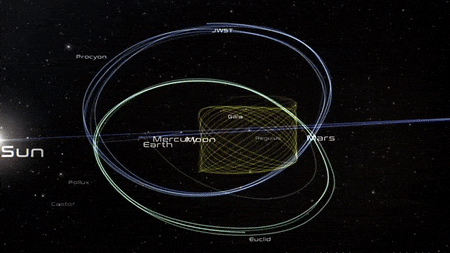
To get to L1 and safely stay in orbit, operators need to know exactly where their spacecraft was, is and will be. To do so, they apply mathematical formulas to the tracking data from the spacecraft to calculate its past, present and future location in a process known as ‘orbit determination’.
Orbit determination is carried out with the help of specially designed software. ISRO has designed and developed new orbit determination software for Aditya-L1. However, given the tiny margin for error that comes with operating a spacecraft at L1, they requested support from ESA to validate it.
ESA puts it to the test
From April to December 2022, ESA and ISRO teams worked together intensively to evaluate ISRO’s strategy for operating Aditya-L1 and challenge their new orbit determination software.
“With its experience flying and even rescuing missions at the Lagrange points, ESA was in the perfect position to help ISRO improve their new orbit determination software and demonstrate that it has the fidelity and accuracy that the organisation needs in order to operate a spacecraft at a Lagrange point for the first time,” says ESA Flight Dynamics expert Frank Budnik.
First, the ESA team invented typical scenarios that the ISRO team could face when operating Aditya-L1. Both teams then used their own orbit determination software to predict how Aditya-L1’s orbit would evolve in these scenarios and compared their results.
The next step saw ESA provide ISRO with simulated tracking data similar to the data that ESA uses to train its own flight dynamics teams. This includes data typical of a spacecraft’s critical Launch and Early Orbit Phase, a complex orbit insertion manoeuvre or even a planetary flyby. The ISRO team used their software to analyse the data, and then both teams worked together to detect any areas that could be improved and fine-tune some of the algorithms.
Finally, the ESA team provided the ISRO team with tracking data from a real spacecraft orbiting L1. Both teams used their own software to analyse the data from ESA’s former LISA Pathfinder mission and compared their results once again.
The results of the exercise were valuable for ESA and ISRO and both teams are confident in the capabilities of ISRO’s software.
It’s not just orbits that come full circle
For some of ESA’s flight dynamics experts, this exercise felt familiar. As ESA prepared to launch its own early deep space missions, it faced similar challenges to those ISRO faces today. ESA reached out to a team from NASA’s Jet Propulsion Laboratory (JPL) to help validate the interplanetary orbit determination software for ESA’s Mars Express mission and for the comet chaser, Rosetta, both of which were then successfully navigated by ESA. The exercise was similar in scope and goal to the one carried out by ESA and ISRO for Aditya-L1 last year.
The international space community
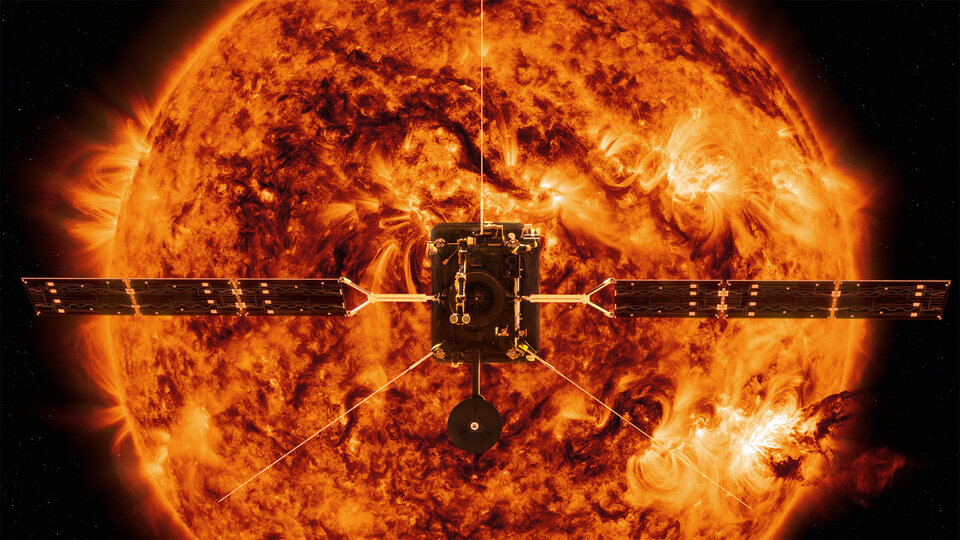
ESA’s two-pronged support to Aditya-L1 demonstrates the value of international spaceflight collaboration. ESA’s ground station network (known as ‘Estrack’) and flight dynamics expertise have been built up over decades of flying the most challenging spacecraft missions and are now cornerstones of the Agency’s support to its partners.
On Earth, Estrack is undergoing an expansion. Construction is underway on ESA’s fourth deep space antenna, as the Agency prepares to meet the rising demand for communication bandwidth from its own deep space and space safety missions and from support to an increasing number of partners.
Meanwhile, in space, Aditya-L1 will be the newest member of the fleet of solar explorers, including ESA’s Solar Orbiter, SOHO, NASA’s Parker Solar Probe and others, on humankind’s shared mission to unravel the mysteries of our star.
Follow @esaoperations on Twitter/X for updates on ESA’s support to Aditya-L1.



